The Sauber C31 has just been unveiled in Jerez and we learn another platypus has been sacrificed at the 2012 F1 altar. Sauber is entering its 20th F1 season and maintains its driving line up from 2011 with Kamui Kobayashi and Sergio Perez. Similarly the relationship with Ferrari as drivetrain supplier remains.
“The Sauber C31-Ferrari boasts a large number of promising new developments, but in other areas it is a systematic further development of last year’s car,†says Team Principal Peter Sauber.
“We’re aiming to start the new season as strongly as we did in 2011, but then also to maintain this level of performance throughout the year,” he added.
“Our goal is to finish regularly in the points so as to put ourselves in a significantly better position in the World Championship.”
Chief Designer Morris is ready to knuckle down and get testing. “The current plan is to launch a fairly basic roll-out version of the car, which was defined quite some time ago. We will then be testing development parts during the upcoming weeks with a late upgrade for the first race on 18th March in Australia. Therefore the car will look quite different in Melbourne compared to the roll-out car,” Morris explained.
More pics of the C31 can be seen after the break.
Sauber F1 Team launches C31 in Jerez
Unveiling & Roll-out
Hinwil/Jerez de la Frontera, 6th February 2012 – Today, Monday, the Sauber F1 Team launches its new car for the 2012 FIA Formula One World Championship. Drivers Kamui Kobayashi (25) and Sergio Pérez (22) unveil the Sauber C31-Ferrari at the Jerez de la Frontera circuit in Spain, where on Tuesday official Formula One pre-season testing will get underway. For filming purposes the C31 will cover its initial laps today.
Goals & paths
The Sauber F1 Team will enter its 20th season in the FIA Formula One World Championship spearheaded by an unchanged driver line-up. With Kamui Kobayashi, Sergio Pérez and reserve driver Esteban Gutiérrez piloting the new Sauber C31-Ferrari, the Swiss outfit will be looking to further improve in 2012. “We’re aiming to start the new season as strongly as we did in 2011, but then also to maintain this level of performance throughout the year,†explains Team Principal Peter Sauber. “Our goal is to finish regularly in the points so as to put ourselves in a significantly better position in the World Championship.â€
Only three of their rivals on this year’s grid have been in Formula One longer than Peter Sauber’s team. After an excellent start to 2011, the team’s form fell away mid-way through the season following the decision to cease development of a controversial technology. “The Sauber C31-Ferrari boasts a large number of promising new developments, but in other areas it is a systematic further development of last year’s car,†says Sauber.
“We are looking forward to another season working with our young and talented drivers,†adds the Team Principal. “Kamui will be competing in his third full season in F1. Last year we asked him to take on leadership responsibilities within the team and he has grown into the role. With his rookie season behind him Sergio is now approaching his second season, which is often the most difficult in a driver’s Formula One career. Both drivers have huge potential and will work with the same race engineers as in 2011 to continue developing that promise. Esteban will be competing full-time in GP2 in his second season in the category and has shown – most recently in the November test – that he could also step into the car for a Grand Prix, if required.â€
Young & quick
The personable Kamui Kobayashi (25) became an instant favourite of Formula One fans on his arrival in the sport, not least with his daring but fair overtaking moves. “2012 will be not only my third season in Formula One, but also my third with the same team,†says the young Japanese. “We’ve been through a lot together and can benefit from our shared experiences. In my first year with the team we had a bad start but a good second half to the season. The second year was the exact reverse. In our third year together we should be a reliable bet to finish consistently in the points. I’m really looking forward to the new season with the Sauber F1 Team.â€
In 2012 Sergio Pérez (22) is setting out to put the lessons from a turbulent but impressive rookie season in 2011 into practice. “My first year in Formula One felt like three years, there were so many new things to take in,†admits the Mexican. “But now I feel like I’ve arrived in Formula One and I’m determined to take a step up in 2012 and achieve better results for the team on a regular basis.â€
20-year-old Esteban Gutiérrez will be focusing on the races in the GP2 Series. “At the same time,†says the team’s other Mexican driver, “I’m looking forward to working more with the Sauber F1 Team. I’m learning a lot by being able to experience and analyse the professionalism and intensity of the team’s work from the inside. It’s good preparation for me.â€
Fresh & evolutionary
Summarising all the efforts put into developing the new Sauber C31-Ferrari, Chief Designer Matt Morris says: “The C31 is revolutionary where we had fresh ideas, particularly at the rear of the car, and it is an evolution where we knew we could carry over certain approaches. We had to improve on the weaknesses we identified on the C30, but at the same time we wanted to maintain its strengths.â€
The engineers opted again to go with a high chassis design. However, according to the new 2012 regulations, the nose cone needs to be lower, which is a safety requirement. As a result, the nose cone has quite a different shape to how it was in the past. The chassis itself shows absolute minimum cross sections all the way to the cockpit.
By an overall tidier design, the front suspension has been optimised for integration with the chassis and the upright. Otherwise it’s a traditional layout with a pushrod and a high-level wishbone.
Packaging was further optimised under the side pods in order to open up more aerodynamic development scope in that area. The cooling layout is based around a similar philosophy to the C30, because that proved to be effective. It helps to get the volume of the coolers forward and allows the design of very compact rear bodywork.
A familiar element of the car is the Ferrari engine, onto which an all-new carbon transmission is bolted – also supplied by Ferrari. The longitudinally mounted transmission is a very tidy, neat unit. The entire rear of the car is much more tightly packaged, helped by the gearbox design, and in addition the engineers have gone in some new directions around the floor at the back of the car. The exhaust tailpipe positions are regulated in 2012, which has had a further effect on how the bodywork design has been set out.
The rear suspension is now a pullrod design. It shows a long pullrod towards the front of the gearbox and wide angled wishbones. This design allows improved packaging of the rear spring and damper elements. Despite the change from pushrod to pullrod, in terms of kinematics the engineers maintained a similar direction to the one they went in for the C30.
Finally, Morris casts a glance at the next steps after the roll-out of the Sauber C31-Ferrari: “The current plan is to launch a fairly basic roll-out version of the car, which was defined quite some time ago. We will then be testing development parts during the upcoming weeks with a late upgrade for the first race on 18th March in Australia. Therefore the car will look quite different in Melbourne compared to the roll-out car.â€
A radical evolution
Summarising all the efforts put into developing the new Sauber C31-Ferrari, Chief Designer Morris says: “The C31 is revolutionary where we had fresh ideas, particularly at the rear of the car, and it is an evolution where we knew we could carry over certain approaches. We had to improve on the weaknesses we identified on the C30, but at the same time we wanted to maintain its strengths.â€
One of the goals was to increase the scope of the operating envelope compared to its predecessor. “We had established some good directions to go in towards the end of last year with the C30 which we wanted to continue with, particularly some of our DRS developments, and some of the ways we were opting for with the car’s set up in order to improve our qualifying performance without compromising our race pace,†elaborates Morris.
The biggest change coming from the new Technical Regulations is that the exhaust position had to be moved away from the floor, which has required quite a new approach.â€
Despite continuity in respect of the tyre supplier, Morris also sees new challenges in this area: “We expect quite different tyre characteristics in 2012. Pirelli is in its second year, so is now beginning to refine its compounds and the tyre’s profile. The compounds generally tend to be heading to slightly softer solutions, slightly more biased to a stronger front tyre than last year. This, of course, changes the way you balance the car.â€
Front end
The engineers opted again to go with a high chassis design. However, according to the new 2012 regulations, the nose cone needs to be lower, which is a safety requirement. As a result, the nose cone has quite a different shape to how it was in the past. The chassis itself shows absolute minimum cross sections all the way to the cockpit.
By an overall tidier design, the front suspension has been optimised for integration with the chassis and the upright. Otherwise it’s a traditional layout with a pushrod and a high-level wishbone. The dampers and springs are packaged quite differently compared to the C30 in order to support a new philosophy for the set-up of the front suspension.
The design of the new front wing benefited from directions the engineers were pursuing towards the end of the 2011 season.
Centre section
Packaging was further optimised under the side pods in order to open up more aerodynamic development scope in that area. The cooling layout is based around a similar philosophy to the C30, because that proved to be effective. It helps to get the volume of the coolers forward and allows the design of very compact rear bodywork.
Also with the roll-hoop the engineers were able to use the C30’s design as a good baseline, and managed to improve what was already a lightweight and aerodynamically efficient solution.
The KERS that Ferrari provided in 2011 was very effective. There were no major issues with its operation or reliability. For the new season Ferrari has improved the system even further.
Rear end
A familiar element of the car is the Ferrari engine, onto which an all-new carbon transmission is bolted – also supplied by Ferrari. The longitudinally mounted transmission is a very tidy, neat unit. The entire rear of the car is much more tightly packaged, helped by the gearbox design, and in addition the engineers have gone in some new directions around the floor at the back of the car. The exhaust tailpipe positions are regulated in 2012, which has had a further effect on how the bodywork design has been set out.
The rear suspension is now a pullrod design. It shows a long pullrod towards the front of the gearbox and wide angled wishbones. This design allows improved packaging of the rear spring and damper elements. Despite the change from pushrod to pullrod, in terms of kinematics the engineers maintained a similar direction to the one they went in for the C30.
The rear wing will again manage without a centre pylon. It is mounted to the endplates and the lower wing, and, of course, maintains its DRS capability.
Morris explains: “Because of the new definition in the rules we know that the disadvantages we had last year with a lack of the strong exhaust effect will be less of an issue for us now. As a result we evolved further our directions from C30 regarding the overall aero development of the car.â€
Finally, Morris casts a glance at the next steps after the roll-out of the Sauber C31-Ferrari: “The current plan is to launch a fairly basic roll-out version of the car, which was defined quite some time ago. We will then be testing development parts during the upcoming weeks with a late upgrade for the first race on 18th March in Australia. Therefore the car will look quite different in Melbourne compared to the roll-out car.â€
Sauber C31-Ferrari technical specifications
Chassis
- Chassis: carbon-fibre monocoque
- Front suspension: upper and lower wishbones, inboard springs and dampers (Sachs Race Engineering) actuated by pushrods
- Rear suspension: upper and lower wishbones, inboard springs and dampers (Sachs Race Engineering) actuated by pullrods
- Brakes: six-piston brake callipers (Brembo), carbon-fibre pads and discs (Brembo)
- Transmission: Ferrari 7-speed quick-shift carbon gearbox, longitudinally mounted, carbon-fibre clutch
- Chassis electronics: MES
- KERS: Ferrari
- Steering wheel: Sauber F1 Team
- Tyres: Pirelli
- Wheels: OZ
Dimensions & weight
- Length: 5,195 mm
- width: 1,800 mm
- height: 1,000 mm
- track width, front: 1,495 mm
- track width, rear: 1,410 mm
- Weight: 640 kg (incl. driver, tank empty)
Ferrari 056 engine
- Type: naturally aspirated V8, 90° cylinder angle
- Engine block: sand-cast aluminium
- Valves / valve train: 32 / pneumatic
- Displacement: 2,398 cc
- Bore: 98 mm
- Weight: > 95 kg
- Electronic injection and ignition
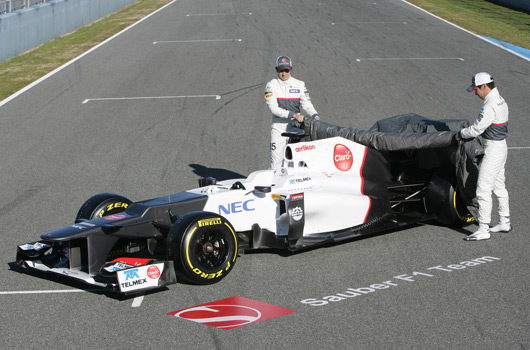
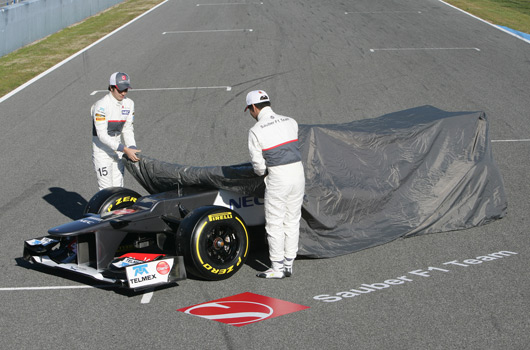
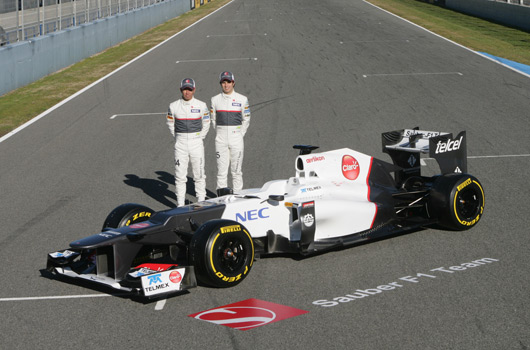
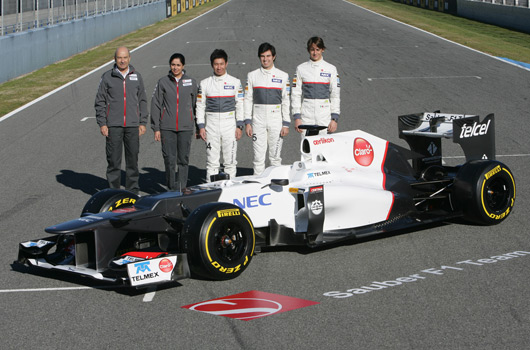
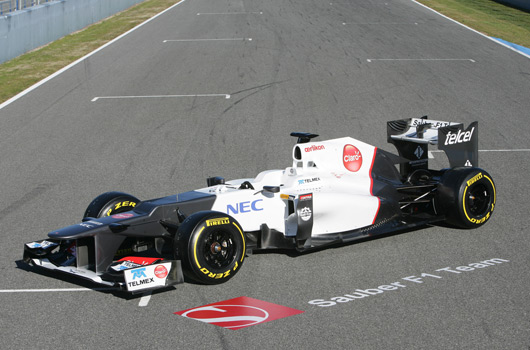
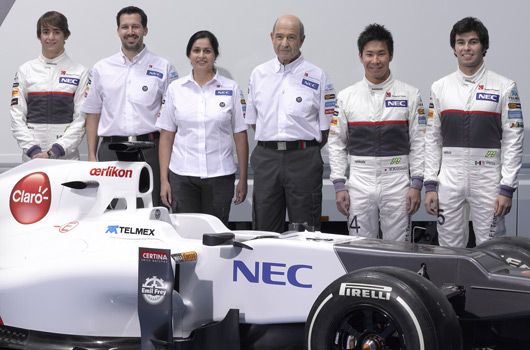
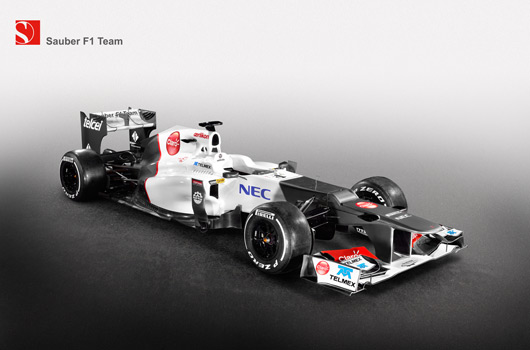
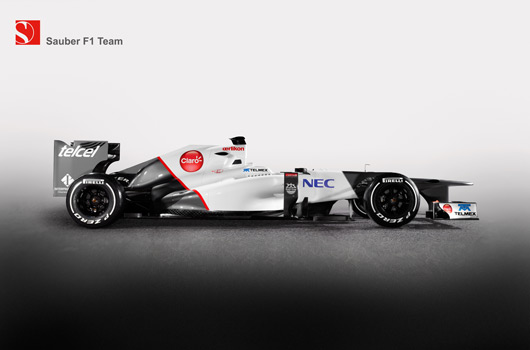
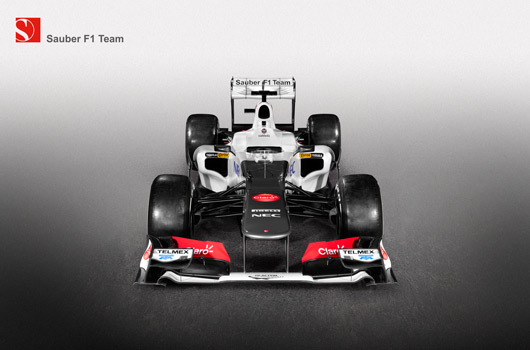
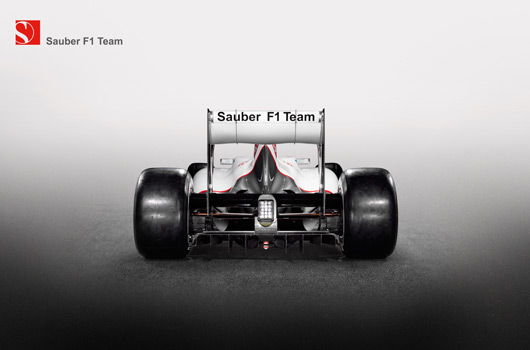
6 replies on “Sauber unveils 2012 F1 car”
[…] Kobayashi took the Sauber C31 to the top of the timesheets on the final day in Barcelona. His best time of 1:22.312 was the […]
[…] impressing was Sergio Perez, who was second fastest in Sauber C31, just 0.04 seconds behind. Sebastian Vettel was next managing a […]
[…] Chassis: C31 […]
[…] Chassis: C31 […]
[…] Kobayashi is at the wheel of the C31, while Sergio Perez calls the shots from a chopper above the […]
[…] Sauber has released images of its new C32-Ferrari, the car it hopes will build on the highly encouraging results from last year’s C31. […]